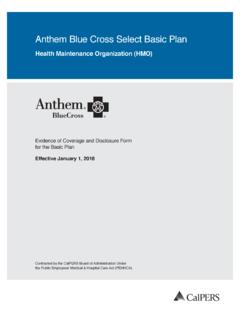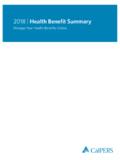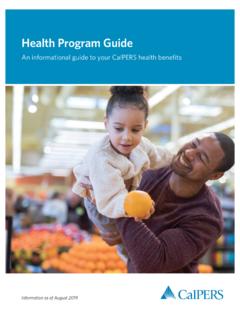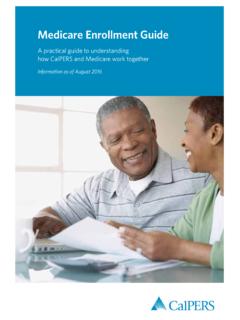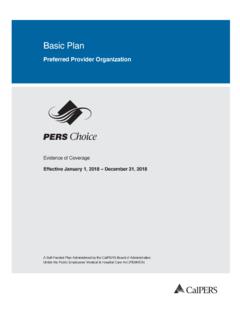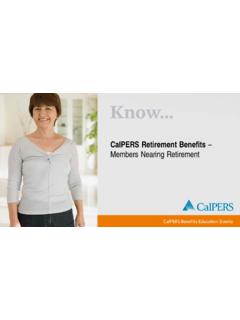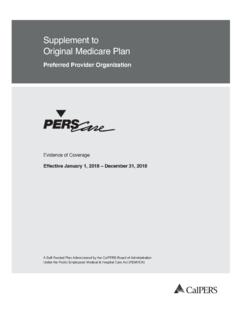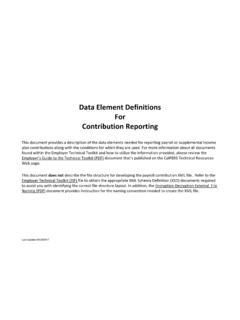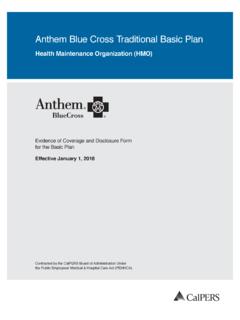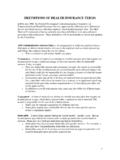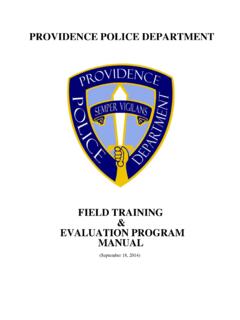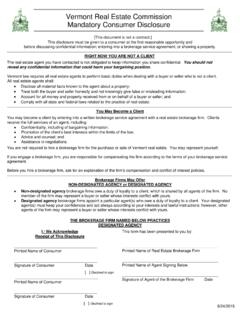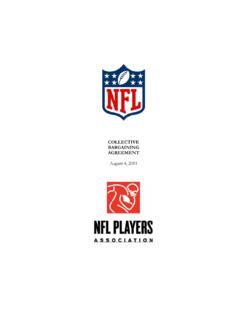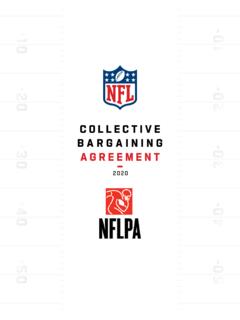Transcription of CalPERS Health Benefits Into Retirement
1 Rev. Date March 2021 Page 1 of 9 CalPERS Health Benefits Into Retirement Disclaimer: CalPERS Health Benefits are governed by the Public Employees Medicare and Hospital Care Act (PEMHCA). Dental is governed by State Employees Dental Care Act. The statements in this document are general. Health and Retirement Laws are complex and subject to change. If there is a conflict between the law and this document, any decisions will be based on the law and not this document. Important! This class is for members who currently work for or are retired from an employer who participates in the CalPERS Health Program. If your employer doesn t participate in the CalPERS Health Program, the following presentation and information doesn t apply to you. Contact your employer to find out about your specific Health Benefits . Agenda This presentation covers information on: Eligibility Enrollment Employer Contribution and Vesting Health Plans Medicare Dental and Vision Coverage Online Tools & ResourcesEligibility Your Eligibility You re eligible to enroll in a plan or continue your Health enrollment as a retiree if you: Separate from employment and retire within 120 days.
2 Your separation and Retirement dates can t be the same date. Your separation date is your last day on payroll with your employer and yourretirement date is the actual Retirement effective date chosen by you. Receive a monthly Retirement allowance Are eligible for Health Benefits on your date of separation Retire from an agency that contracts with us for Health Benefits for your bargaining groupFamily Member Eligibility Once you re enrolled, you may wish to enroll your family members as your dependents. Eligible dependents include: Your spouse or registered domestic partner Natural, adopted or stepchildren, up to age 26 Certified disabled children who were disabled prior to age 26 Rev. Date March 2021 Page 2 of 9 A child in a parent-child relationship with you, such as a grandchild who s dependent upon you fortheir financial supportThere are those who are not eligible to be covered as a dependent on your plan, for example, your ex-spouse cannot be covered.
3 It s against the law to continue enrollment of an ineligible family member. If this occurs, you may be responsible for all costs incurred during the period in which they were ineligible. Survivor Eligibility Upon your death in Retirement , surviving family members are eligible for Health benefit coverage if they: Receive a monthly survivor check The monthly survivor benefit can be a survivor continuancebenefit contracted for by your employer, or a death benefit check they receive because youselected a Retirement option that provides a monthly lifetime benefit. Were eligible dependents at the time of your death. For example, a child up to age of 26 or an ex-spouse would not be Health Program Guide (HBD-120) ( PDF) can assist you with eligibility requirements and the documentation required to enroll your eligible dependents. Enrollment Retirement Enrollment Timeline The length of time between your separation date and your Retirement date not only dictate whether you re eligible for Health Benefits , but it also determines how your enrollment continues into Retirement .
4 If your separation and Retirement dates are: Within 30 days: If you re enrolled in Health Benefits at the time of your separation, your healthcoverage will continue into Retirement automatically including all eligible family members enrolledon your plan prior to your Retirement . There is no break in coverage between your employmentcoverage and your Retirement coverage. Be twe e n 31 and 120 days: Your Health coverage will not continue into Retirement , which couldresult in a lapse in coverage. At this point you can:oEnroll in direct pay through your employer which allows you to pay the full gross premiumdirectly to the Health planoRequest to re-enroll within 60 days of your Retirement dateoRe-enroll during the next open enrollment period with coverage going into effect thefollowing January 1oQualify for a 90-day late enrollment More than 120 days: You re not eligible for Health Benefits into retirementIf you don t want your Health Benefits to continue into Retirement , you can cancel your coverage through your employer before you retire.
5 You may also decline coverage into Retirement in the Service Retirement Election Application (PDF) form. Rev. Date March 2021 Page 3 of 9 Open Enrollment Open enrollment is the one time each year when you can make changes to your Health Benefits without a qualifying event. It s traditionally held in the fall with changes effective the following January 1. During open enrollment you can: Enroll in a Health or dental plan Change Health plans Add or delete eligible family members Cancel all coverageOpen enrollment information will be available in your myCalPERS account. Here you ll find information about your current plan, premiums, and which plans are available to you. When you retire, you ll also be able to make open enrollment changes in your myCalPERS account. While you re working, open enrollment changes still need to be done through your employer. Special Enrollment Special enrollments are qualifying events that allow you to make changes to your Health enrollment without having to wait for the next open enrollment period.
6 Marriage, registration of a new domestic partnership, Medicare eligibility, birth, adoption or placement for adoption of a child, involuntary loss of coverage, and court-ordered coverage for eligible family members are some examples of special enrollments. Request to make changes to your Health Benefits based on a special enrollment must be made within 60 days of the qualifying event. The change goes into effect the first of the following month from when all required documentation is received. Late Enrollment Late enrollment applies when there is no qualifying event to allow enrollment or the request for special enrollment is made outside of the 60-day period. There is a 90-day waiting period for late enrollments. The effective date of the change is the first of the month following the waiting period. mandatory Enrollment Changes mandatory qualifying events require you by law to make a change to your enrollment. The effective date of a mandatory qualifying event is the first of the month following the event.
7 Examples of mandatory qualifying events include: Divorce or termination of a domestic partnership Death of a dependent family member Death of a CalPERS memberYou may be required to provide supporting documentation to add or delete a dependent family member. For example, a divorce or termination of a domestic partnership requires a copy of the divorce decree or the Termination of Domestic Partnership (PDF) from the Secretary of State to delete the dependent. Rev. Date March 2021 Page 4 of 9 Find more information on the supporting documentation requirements by reading the Health Program Guide (HBD-120) ( PDF). Unlawful Enrollments Types of enrollments that are not allowed are: Dual coverage You are only permitted one CalPERS Health enrollment, meaning you can t beenrolled in your own CalPERS Health plan as the subscriber and a dependent on another person sCalPERS plan. Split enrollment All dependents must be covered under one Contribution and Vesting The employer contribution is the amount your employer will contribute to your Health plan premium in Retirement .
8 Vesting refers to the amount of time you must be employed by your employer in order to receive their contribution toward your Health premium at Retirement . Public Agency and School Contributions If you re retiring from a public agency or school, your employer s monthly contribution is established by contract. Your employer has the power to make changes or cancellations to the contract. Contact your employer for contribution amounts and any vesting requirements. State and CSU Contributions When you retire from the State of California or the California State University (CSU) you may receive the state s contribution towards your Health plan premium in Retirement . Employer contributions are subject to collective bargaining and can be found on the Retiree Plans & Rates webpage. State of California Vesting If you were first hired by the state: Before January 1, 1985 and are eligible to retire, you will receive 100 percent of the state scontribution Be twe e n January 1, 1985 through January 1, 1989, you ne e d 10 years of CalPERS service credit toreceive 100 percent of the state s contribution.
9 In this case, CalPERS service credit includes servicewith a state agency, public agency, and schools. After January 1, 1989, you need 20 years of state service to receive 100 percent of the state scontribution After January 1, 2011, some bargaining units require 25 years to receive 100 percent of the state scontributionRev. Date March 2021 Page 5 of 9 CSU Vesting If you: Established CalPERS membership prior to July 1, 2017 and retire from a CSU, you ll re ce ive 100 percent of the state s contribution Were first hired by a CSU in bargaining unit 3 on or after July 1, 2017, then you need 10 years ofservice to get 100 percent of the state s contribution Were first hired by a CSU on or after July 1, 2018 in bargaining units 1, 2, 4-7, 9, 10, and non-represented then you need 10 years of service to get 100 percent of the state s contributionSome members are exempt from vesting requirements. If you retire from the Legislative Branch, including Senate and Assembly Rules, or from the State of California on a disability or industrial disability Retirement , you re exempt from the state s vesting requirements.
10 Also, family members who qualify as a surviving annuitant due to an active member s death are also exempt from state vesting requirements. Even if you receive 100 percent of the state s contribution toward your Health Benefits , this may or may not cover 100 percent of the premium. This means that if your Health plan premium is more than the state s contribution, you ll be required to pay the remaining balance. Health Plans CalPERS Health Plan Types We offer different types of Health plans. The availability of these plans vary depending on where you live or work. Preferred Provider Organizations (PPO) are available worldwide and generally allow greaterflexibility when choosing providers. There is a yearly deductible, but you don t need a referralneeded to see a specialist. Health Maintenance Organizations (HMO) For an HMO, healthcare is provided within the plan spredefined network and you must select a primary care provider. HMOs are geographicallyrestricted, and you need a referral to see a specialist.

